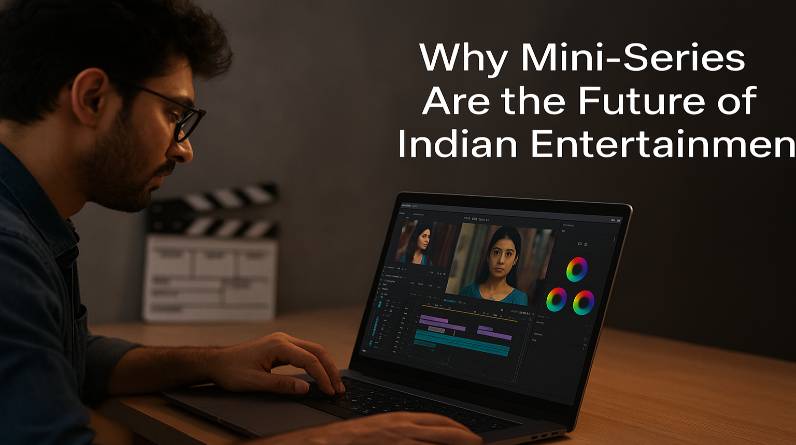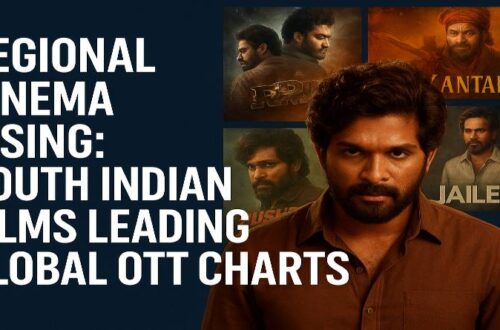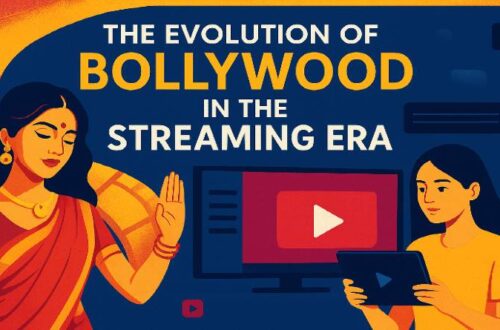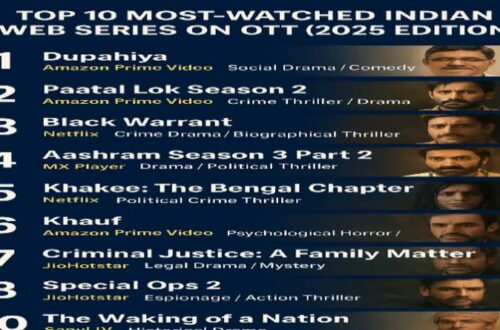The Changing Pulse of Indian Storytelling
Indian entertainment is witnessing a quiet revolution. Gone are the days when three-hour Bollywood blockbusters or 500-episode TV dramas dominated living rooms. Today’s audiences — especially digital-first millennials and Gen Z — crave concise, high-quality storytelling that fits their fast-paced lives. This is where mini-series have stepped into the spotlight, redefining how stories are told, consumed, and remembered.
Mini-series — short-format shows typically running between 4 to 10 episodes — have become the sweet spot between cinema and television, offering cinematic quality with the narrative depth of long-form storytelling.
The Shift from Big Screens to Compact Streaming
The rise of OTT (Over-The-Top) platforms such as Netflix, Amazon Prime Video, Disney+ Hotstar, and SonyLIV has catalyzed this transformation. With over 500 million active internet users and nearly 45% of India’s OTT viewership coming from Tier 2 and Tier 3 cities, audiences are rapidly shifting from cinema halls to home screens.
The COVID-19 pandemic accelerated this shift. While theatres shut down, streaming platforms became the new stage for filmmakers and actors to reach their audiences. Mini-series like Scam 1992, Paatal Lok, and Aarya achieved cult status — proving that shorter, gripping formats could deliver both artistic and commercial success.
| Format | Typical Length | Platform | Viewer Engagement | Example |
| Traditional TV Shows | 100+ episodes | Linear TV | Moderate, declines over time | Kyunki Saas Bhi Kabhi Bahu Thi |
| Web Series | 8–12 episodes | OTT | Strong, with binge-watch appeal | Mirzapur |
| Mini-Series | 4–8 episodes | OTT & TV | High, concentrated engagement | Scam 1992, Rocket Boys |
Why Mini-Series Resonate with Modern Audiences
1. Time Efficiency Meets Narrative Depth
Audiences today prefer “snackable yet substantial” content. Mini-series balance brevity with depth — allowing creators to tell focused, meaningful stories without unnecessary filler episodes. For instance, Trial by Fire (Netflix) delivered a powerful real-life story in just seven episodes — emotionally rich yet succinct. This efficient storytelling appeals to viewers who may not commit to 50-hour sagas but still crave immersive narratives.
2. Creative Freedom for Storytellers
OTT platforms have democratized creativity. Writers and directors are no longer bound by box-office metrics or TV TRP pressures. Mini-series give them the liberty to explore complex themes — from politics and crime to gender, identity, and mental health — often considered too “niche” for mainstream cinema. For example, Mai and Tabbar explored dark, character-driven stories that would have been risky theatrical ventures.
3. Better Character Arcs and Emotional Payoffs
Unlike films that must resolve in 2–3 hours, mini-series allow slow-burn storytelling — deep character development, layered emotions, and richer payoffs. This format also encourages multiple perspectives, giving rise to nuanced storytelling that resonates globally.
4. Higher Production Quality, Lower Financial Risk
Mini-series often operate with smaller budgets than full-length films but maintain cinematic production standards. This allows creators to experiment without risking massive losses. OTT platforms like Netflix and Amazon are investing heavily in Indian mini-series, often collaborating with indie filmmakers and studios.
| Production Comparison (2024 data) | Average Budget per Episode (INR) | ROI Potential |
| Feature Films | ₹10–50 crore | High risk, depends on box office |
| Regular Web Series | ₹1–3 crore | Moderate |
| Mini-Series | ₹0.5–1.5 crore | High ROI, low risk |
How Mini-Series Are Transforming the Industry
1. New Career Pathways for Artists
Mini-series are giving emerging actors, writers, and directors a major breakthrough. Many now bypass the traditional film industry hierarchy. For instance, Pratik Gandhi became a household name after Scam 1992. Shefali Shah’s comeback with Delhi Crime earned India its first International Emmy. Filmmakers like Hansal Mehta, Suparn Verma, and Raj & DK have found new audiences and global recognition.
2. Localization and Regional Storytelling
The mini-series format has also sparked a regional renaissance. Platforms are commissioning series in Tamil, Telugu, Malayalam, Marathi, and Bengali — each exploring local stories with universal appeal. Suzhal – The Vortex (Tamil) and Jhansi (Telugu) show that regional storytelling in compact form can travel far beyond linguistic boundaries, reaching global audiences through subtitles and dubbing.
3. Experimentation and Genre Diversity
Mini-series are pushing the envelope with genre experimentation — from thrillers (The Night Manager), to courtroom dramas (Illegal), to biopics (Rocket Boys). This flexibility allows creators to test audience responses before committing to longer seasons — a data-driven evolution in entertainment production.
Global Influence: The Korean and Western Effect
India’s growing appetite for mini-series mirrors trends abroad. Korean dramas, known for their limited episodes and emotional depth, have found massive popularity in India. Western shows like Chernobyl and Queen’s Gambit have also set benchmarks for storytelling economy. Indian creators are learning from these formats — emphasizing tight scripts, strong character arcs, and binge-worthiness. OTT giants now view India as the next big export hub for international mini-series collaborations.
The Audience Equation: Data Doesn’t Lie
According to a 2024 report by Ormax Media and FICCI-EY, over 65% of OTT viewers in India prefer limited-episode content because it allows them to finish shows in 2–3 sittings. Moreover, engagement analytics from platforms like Netflix and Amazon show that mini-series boast 20–30% higher completion rates than long-format shows.
| Viewer Preference Study (India, 2024) | Percentage |
| Prefer mini-series/limited series | 65% |
| Prefer long web series (8+ episodes) | 25% |
| Prefer traditional TV shows | 10% |
These numbers highlight a clear trend — Indian audiences value quality over quantity.
Hybrid Futures and Creative Evolution
The line between cinema and streaming continues to blur. As theatrical releases and OTT premieres coexist, the mini-series model offers a hybrid future — combining cinematic ambition with episodic flexibility.
In the coming years, expect to see:
- Collaborative productions between film studios and OTT platforms
- Interactive mini-series using AI and viewer-driven narratives
- Cross-format storytelling, where a theatrical film evolves into a spin-off mini-series
For creators, mini-series are not just an artistic medium — they’re a strategic evolution. For audiences, they represent a smarter, richer, and more convenient entertainment experience.
Conclusion: The Compact Future of Indian Storytelling
Mini-series are not a passing trend — they are the future blueprint of Indian entertainment. As audiences demand sharper narratives and global streaming competition intensifies, this format perfectly bridges creativity, accessibility, and business sustainability.
From regional gems to high-octane thrillers, mini-series are shaping a new golden era for Indian storytellers — one episode at a time.
Frequently Asked Questions (FAQs)
- What is a mini-series in Indian entertainment?
A mini-series is a short-format show typically spanning 4–8 episodes. It delivers a complete story with cinematic quality, making it ideal for digital platforms and modern audiences with limited time. - Why are mini-series gaining popularity in India?
Mini-series attract viewers with their compact storytelling, faster pacing, and strong character development. They fit perfectly into the on-the-go lifestyles of OTT audiences who prefer binge-worthy yet short content. - How do mini-series benefit creators and producers?
Mini-series allow creators to experiment with bold narratives at lower production costs. They also carry less financial risk compared to feature films, while maintaining high ROI and global reach. - Are mini-series replacing traditional TV and films?
Not entirely. Mini-series coexist with films and long-form web shows. They bridge the gap by offering cinematic depth and episodic flexibility—ideal for the OTT-first audience. - Which OTT platforms are focusing on mini-series in India?
Platforms like Netflix, Amazon Prime Video, Disney+ Hotstar, and SonyLIV have launched several successful mini-series, while new vertical-format apps such as Amazon MiniTV and ReelShort are expanding the format’s reach. - How do audience habits influence the rise of mini-series?
With shorter attention spans and mobile-first viewing habits, audiences prefer content they can finish quickly. Mini-series deliver emotional satisfaction without demanding long viewing commitments. - What’s the future of mini-series in India?
Mini-series will continue to grow as OTT platforms invest in regional and genre-diverse content. Expect hybrid projects that merge cinema and digital storytelling for a global audience.




